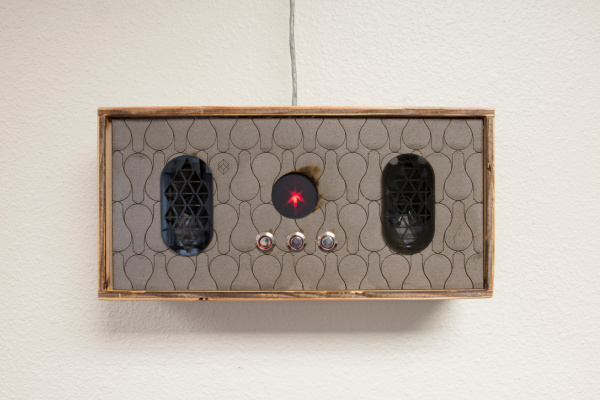Interactive Hanging LED Array
Interactivity
A whole bunch of lights in a grid is not a boring thing, but, if it doesn't react to its environment, you've basically just made a huge, mega-low resolution television display. I decided to create a few different modes to allow the installation to react and respond in different ways. The nice thing about programmable microcontrollers, like the Arduino's ATmega328, is that you can very quickly write and test a lot of firmware without even touching your hardware layout.
I spent a few days just writing new sketches and hooking up new sensors to play with ideas and find out what the most engaging and stable types of interaction would be. At one point I used blinking lights to entice people to walk within range of a sensor, which would then alert them to their effect on the lights, but not everyone's reaction to blinking lights is the same. I also wrote a whole bunch of simple animations for the display, just sweeping lines of light around the room or creating the illusion of flashing fireflies.
My favorite experiments used ultrasonic range finders as an input device. Ultrasonics are nice and stable and aren't affected by changes in ambient light, they also have a long enough range and wide enough detection zone to work as general activity monitors if they're strategically placed. I decided to add 2 Maxbotix Range Finders to the installation, on either end of the conference room. Each one would run to a different ADC on the Arduino so I could read them quickly and independently. I simply taped them to the wall with a bit of foam tape; they're so small you hardly notice them.
My favorite application of the range finders was for playing pong. I built a single player pong game that could be played by moving back and forth along the side of the playing field. There are only three paddle positions, but they map really closely to which lightbulbs you're standing underneath. The game is actually pretty fun and fast paced.
Along with the range finders, I wanted some kind of sounds interaction. Unfortunately, ambient sound reaction is hit or miss. Our brains are so good at filtering sound that we often don't realize how noisy a room is until we ask a computer to monitor it. The difference between a "quiet" room and a meeting might be more in the frequency spectrum than the actual loudness level. I really wanted to get one of our Spectrum Shields into the project, though, because creating a music visualizer is so easy and rewarding for big displays. I decided to take a clean music source as the input. At first it was a direct line from the headphone jack on the device, but I later decided to add Bluetooth audio.
Bluetooth connectivity came courtesy of the RN-52 Audio Bluetooth Breakout, which made it pretty easy to get up and running. There's a great hookup guide on our site that explains how to use the RN-52 as a bluetooth boombox, and that's pretty much what I did.
I made an enclosure for the Bluetooth audio portion of the installation, which houses a couple of speakers as well as a few buttons for user input and a Bluetooth status LED. I hung the enclosure on the wall where it would be easy to see and manipulate and ran a cable back to the control cabinet for power. That cable also carried an audio signal from one of the speakers to a Spectrum Shield, which I wired to the 3V Pro Mini using a Logic Level Converter.
